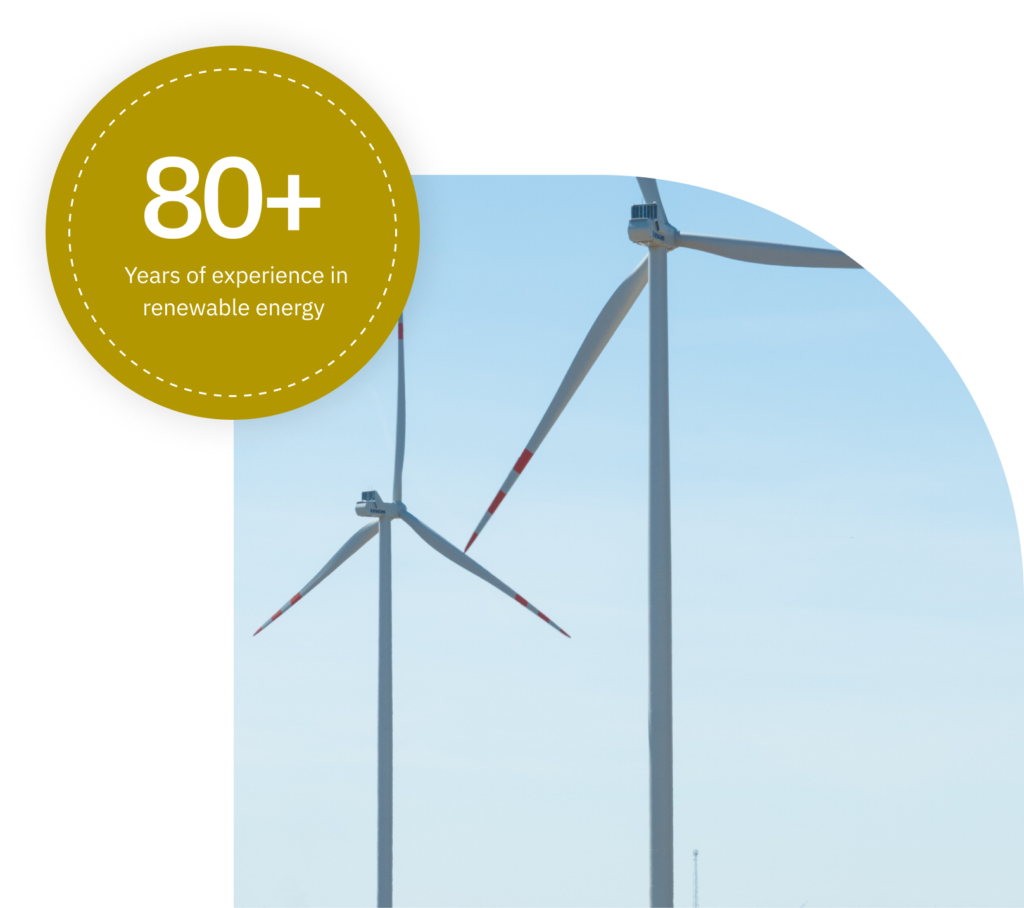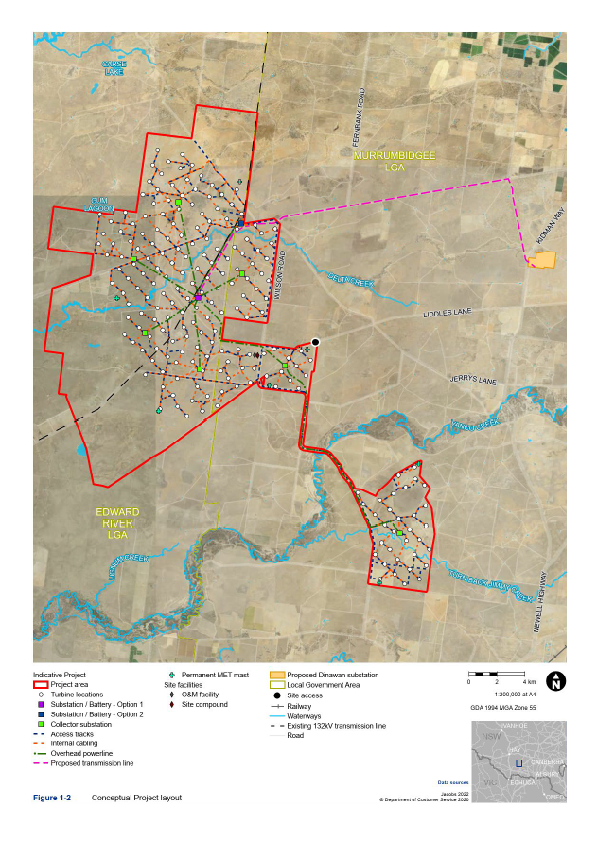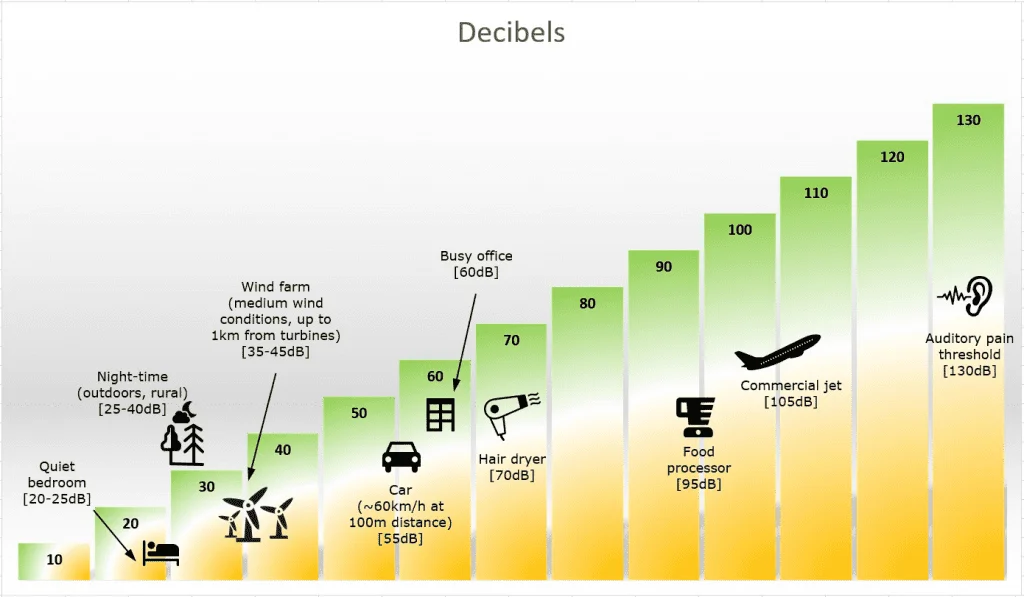Yanco Delta
Wind and Energy Storage
intending to make a real difference
Project Details

Project Particulars
Location
10-40km north-west of
Jerilderie, NSW
Wind Turbines
Up to 208 with tip
heights of 270m
Battery Energy
Storage System
800MW/800MWh (alternate durations are possible)
Total Generation
Capacity
1,500MW (1.5GW)
Proposed
Connection
Dinawan Substation
Location
10-40km north-west of
Jerilderie, NSW
Host
Landholders
8
Equivalent
Power
Enough to power ~ 750,000+ households [1]
CO2 Avoidance
3.3 – 4.5 million tonnes CO2-e per annum depending on calculation methodology [2]

Yanco Delta Key Benefits
The Project’s construction is expected to last for years and employee hundreds of people.
The on-going operations and maintenance would last for decades and employ scores of mechanical and electrical technicians as well as supervisory and administrative roles.
Yanco Delta would deliver low-cost, renewable energy to the grid and support the NSW 82% renewable energy by 2030 and 2050 net-zero emissions targets
The Project would provide financial contributions to landowners, helping to ‘drought-proof’ their farming operations
The project would fund landmark projects in consultation with both local Councils and the community
Yanco Delta’s Development Process
with Section 20 of Schedule 1 of the State Environmental Planning Policy (Planning Systems) 2021
-
01
-
02
-
03
-
04
-
05
The Environmental Impact Statement (EIS) applications is underpinned by
significant technical, environmental and social studies, including:
Biodiversity
Aboriginal heritage
Non-Aboriginal heritage
Land use and property
Landscape character and visual impacts
Noise and vibration
Traffic and transport
Soils and contamination
Surface water, groundwater and flooding
Socio-economic impacts
Hazards and risks
Air quality
Greenhouse gas
Other issues including waste and sustainability
The EIS includes requirements for environmental management plans to monitor, manage and report on all
environmental impacts during the lifetime of the Project, and decommissioning plans at the end of the Project.
Yanco Delta’s Indicative Timeline
-
01
-
02
-
03
-
04
-
05
-
06
-
07
-
08
-
09
-
10
-
11
-
12
Project announced to industry, government and community. Completed 2021
Consultation and preliminary technical studies undertaken Completed in April 2022
Secretary's Environmental Assessment Requirements are issued Received May 2022
Community engagement and technical studies to inform the EIS Completed October 2022
Public exhibition for agency and community comment completed end of 2022
Addressing comments and issues raised about the EIS in a response to submissions report Expected Completion 2023
Assessment and recommendation by the Department of Planning and Environment Expected Completion 2023
The Minister of Planning, or the Independent Planning Commission decides the proposal Expected Completion 2023
Grid access and award expected completion 2024
Peferred technology and delivery partners expected completion 2025
Final investment decision and construction commencement expected completion 2025/2026
Commercial operations expected completion 2027-2029
FAQs
The natural power of the wind turns the blades of a rotor. This rotor is connected to a gear box via a low-speed shaft.
The gearbox is connected to a generator via a high-speed shaft which rotators to produce electricity.
Transformers convert this electricity from low to high voltage, which is the transmitted via supporting electrical infrastructure such as transmission line to the substation and then a terminal station.
There will be up to 210 wind turbines as part of the Yanco Delta Wind Farm.
The turbines will be located across eight different private properties, which the infrastructure sitting across 33,000 hectares.
Virya Energy has entered into landholder agreements with each of the eight landholders.
The wind turbines will be up to 270 m tall from the bottom of the tower to the tip of the blade.
A wind farm Project will have a full lifespan of around 40 years and can be broken down into the following phases:
- Project development
- Community consultation
- Environmental approvals
- Planning and financing generally take 4-7 years to complete.
- Construction and commission
- Operation
- Upgrading or decommissioning
The construction and commissioning period will generally take around 2-3 years and once commissioned, the operational life of a wind turbine is currently around 30 years.
At the end of this time the turbines can be refurbished or upgraded or alternatively the wind farm may be decommissioned, and the landscape is returned to its former condition.
Wind energy is a clean, renewable and reliable energy source, and is a significant contributor toward the transition of our energy system away from emissions intensive sources.
Zero emissions are created during the generation of electricity by wind turbines, and any emissions generated in the manufacture, construction and maintenance are offset within a year of operation.
The land, biodiversity and environmental impacts of wind farms are significantly lower than those created in mining and burning fossil fuels.
In addition, most turbine components are now recyclable with the valuable steel, copper and aluminium, as well as the carbon fibre blades, all being recycled.
Virya believes in sharing the benefits of its wind farms with the local community. Many local businesses will be engaged to work directly on the project, employing local people. There is a significant benefit in increased economic activity in the region through accommodation, food and equipment hire, as well as a drought proof income to landowners, who in-turn spend more in the local economy.
In every community we build our projects, we work in partnership with the community and listen to the community’s needs through both formal and informal community consultation. We will also establish a community benefit fund for local organisations and projects, and a community committee will determine how that funding is distributed to best support the region.
Audio impacts from the operation of the turbines are assessed and mitigated as part of the extensive environmental approvals process, and this includes designing a suitable buffer between turbines and any residences to reduce any impact on neighbouring properties. When operational, the movement of the blades through the air generates some noise, and how loudly this is experienced varies with wind speed, topography and other factors. Advances in turbine design have reduced the noise impacts, and a normal conversation can be held when standing below a turbine without needing to raise your voice.
The table below gives an indication of the noise levels to be anticipated at a distance of 500-1000m from a turbine, in the context of noise levels we experience every day, although Virya will not place a turbine within 2km of a neighbouring dwelling, ensuring noise levels are even lower than required.
In every community we build our projects, we work in partnership with the community and listen to the community’s needs through both formal and informal community consultation. We will also establish a community benefit fund for local organisations and projects, and a community committee will determine how that funding is distributed to best support the region.
A study by the NHMRC, Wind Turbines and Health, A Rapid Review of the Evidence, (July 2010) found that “there is no evidence for direct adverse health effects from these [wind turbine] installations.”
On very rare occasions some turbines have experienced electrical or mechanical failures that have started fires.
These fires are generally contained in the top of the turbine, with turbine monitoring systems alerting fire crews, who can then ensure no spot-fires start at the base of the tower.
Modern wind turbines are also fitted with fire suppressant systems to automatically put out fires and the regular maintenance of equipment greatly reduces the chance of fires being started.
State and Federal fire authorities have consistently stated that they do not consider wind turbines to be a fire risk and that the access tracks act as fire breaks, while also providing good access for fire trucks to otherwise inaccessible areas.
Wind farms have little impact on most birds and bats as they predominantly fly below the swept area of the blade.
Some migratory birds and soaring birds, such as eagles, do fly at the height of the blades. As such, flight paths studies are carried out to make sure that turbines are not placed in migratory flight paths or near cliffs where birds soar.
Ground studies are also undertaken to identify habitat of vulnerable land dwelling animals. Considering wind farms use less than 1% of the property they are located on, there is plenty of room to reposition turbines, tracks or cable routes away from areas of potential impact, avoiding or minimising habitat removal.
When compared against the CER’s Scope 2 emissions intensity factor for NSW (0.73 tonnes CO2-e/MWh as at 2022-2023*), Yanco Delta wind farm, if developed to its maximum wind generation capacity, could avoid approximately 3.3 million tonnes of CO2-e per annum. This estimate is expected to decrease as the quantity of renewables increases in the market over time.
*https://www.cleanenergyregulator.gov.au/OSR/EERS/eers-current-release (as at 12/10/2023)
When compared against the displacement of black coal-fired generation (with an emissions intensity of approximately 1 tonne C02-e/MWh), Yanco Delta wind farm, if developed to its maximum wind generation capacity, could avoid approximately 4.5 million tonnes of CO2-e per annum.
The effects of a possible Battery Energy Storage System (BESS) are excluded from calculation for simplicity.
When compared against the reasonable estimate of an average household consuming ~6,000kWh of network electricity per year (~16kWh/day/household), Yanco Delta wind farm, if developed to its maximum wind generation capacity, could plausibly supply the volume of clean energy to meet the demands of 750,000 typical households. This number is expected to increase over time in the event household energy efficiency improves and/or greater rooftop solar penetration reduces nett household electricity demand.
The effects of a possible Battery Energy Storage System (BESS) are excluded from calculation for simplicity.
All calculations founded on an assumed and approximate nett average wind farm export of 4,500,000MWh/yr.
